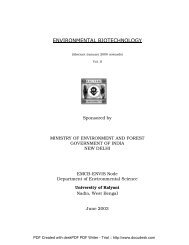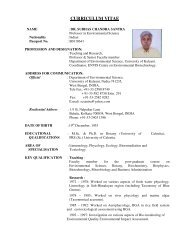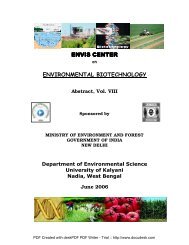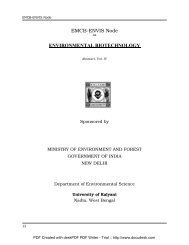EMCB-ENVIS Node ENVIRONMENTAL BIOTECHNOLOGY
EMCB-ENVIS Node ENVIRONMENTAL BIOTECHNOLOGY
EMCB-ENVIS Node ENVIRONMENTAL BIOTECHNOLOGY
Create successful ePaper yourself
Turn your PDF publications into a flip-book with our unique Google optimized e-Paper software.
<strong>EMCB</strong>-<strong>ENVIS</strong> Centre<br />
activation of the metabolism that leads to purine degradation in the filamentous freshwater<br />
cyanobacterium Planktothrix sp. FP1. The purine catabolic pathway is related to the nitrogen<br />
microcycle in water environments, in which cyanobacteria use traces of purines and ureides as a<br />
nitrogen source for growth. Thus, the activity of allantoicase, a key inducible enzyme of this<br />
metabolism, was used as tool for assaying the activation of the purine degradation pathway. The<br />
enzyme and the pathway were induced by allantoic acid, the direct substrate of allantoicase, as<br />
well as by adenine and, to a lower degree, by urea, one of the main products of purine<br />
catabolism. Crude cell extract of Escherichia coli was also employed and showed the best<br />
induction of allantoicase activity. In culture, Planktothrix sp. FP1 showed a differential<br />
accumulation of PST in consequence of the induction with different substrates. The<br />
cyanobacterial culture induced with allantoic acid accumulated 61.7% more toxins in comparison<br />
with the control. On the other hand, the cultures induced with adenine, urea, and the E. coli<br />
extract showed low PST accumulation, respectively, 1%, 38%, and 5% of the total toxins content<br />
detected in the noninduced culture. A degradation pathway for the PSTs can be hypothesised: as<br />
suggested for purine alkaloids in higher plants, saxitoxin (STX) and derivatives may also be<br />
converted into xanthine, urea, and further to CO2 and NH4+ or recycled in the primary<br />
metabolism through the purine degradation pathway.<br />
Friedrich Widdel and Ralf Rabuszx. (Max-Planck-Institut für Marine Mikrobiologie,<br />
Celsiusstrasse 1, D-28359 Bremen, Germany). Anaerobic biodegradation of saturated<br />
and aromatic hydrocarbons. Current Opinion in Biotechnology, 12(3) (2001), 259-276.<br />
Saturated and aromatic hydrocarbons are wide-spread in our environment. These compounds<br />
exhibit low chemical reactivity and for many decades were thought to undergo biodegradation<br />
only in the presence of free oxygen. During the past decade, however, an increasing number of<br />
microorganisms have been detected that degrade hydrocarbons under strictly anoxic conditions.<br />
G. M. Walker, L. R. Weatherley. (School of Chemical Engineering, The Queen's University of<br />
Belfast, Belfast BT9 5AG, Northern Ireland, UK. Department of Chemical and Process<br />
Engineering, University of Canterbury, Christchurch, New Zealand). Biodegradation and<br />
biosorption of acid anthraquinone dye. Environmental Pollution, 108(2) (2000), 219-<br />
223.<br />
The acid anthraquinone dye Tectilon Blue (TB4R) is a major coloured component from the<br />
aqueous effluent of a carpet printing plant in Northern Ireland. The aerobic biodegradation of<br />
TB4R has been investigated experimentally in batch systems, using three strains of bacteria,<br />
namely, Bacillus gordonae (NCIMB 12553), Bacillus benzeovorans (NCIMB 12555) and<br />
Pseudomonas putida (NCIMB 9776). All three strains successfully decolourised the dye, and<br />
results were correlated using Michaelis–Menten kinetic theory. A recalculation of the reaction<br />
rate constants, to account for biosorption, gave an accurate simulation of the colour removal over<br />
a 24-h period. Up to 19% of the decolorisation was found to be caused by biosorption of the dye<br />
onto the biomass, with the majority of the decolorisation caused by utilisation of the dye by the<br />
bacteria. The reaction rate was found to be intermediate between zero and first order at dye<br />
concentrations of 200–1000 mg/l.<br />
Hanumanthanaik P Doddamani, Harichandra Z Ninnekar. (Department of Biochemistry,<br />
Karnatak University, Dharwad-580 003, India). Biodegradation of Carbaryl by a<br />
Micrococcus Species. Current Microbiology, 43(1) (2001), 0069 – 0073.<br />
A bacterium capable of utilizing carbaryl as sole source of carbon was isolated from garden soil<br />
and identified as a Micrococcus species. The organism also utilized carbofuran, naphthalene, 1naphthol,<br />
and several other aromatic compounds as growth substrates. The organism degraded<br />
carbaryl by hydrolysis to yield 1-naphthol and methylamine. 1-Naphthol was further metabolized<br />
via salicylate by a gentisate pathway, as evidenced by oxygen uptake and enzymatic studies.<br />
56<br />
PDF Created with deskPDF PDF Writer - Trial :: http://www.docudesk.com







